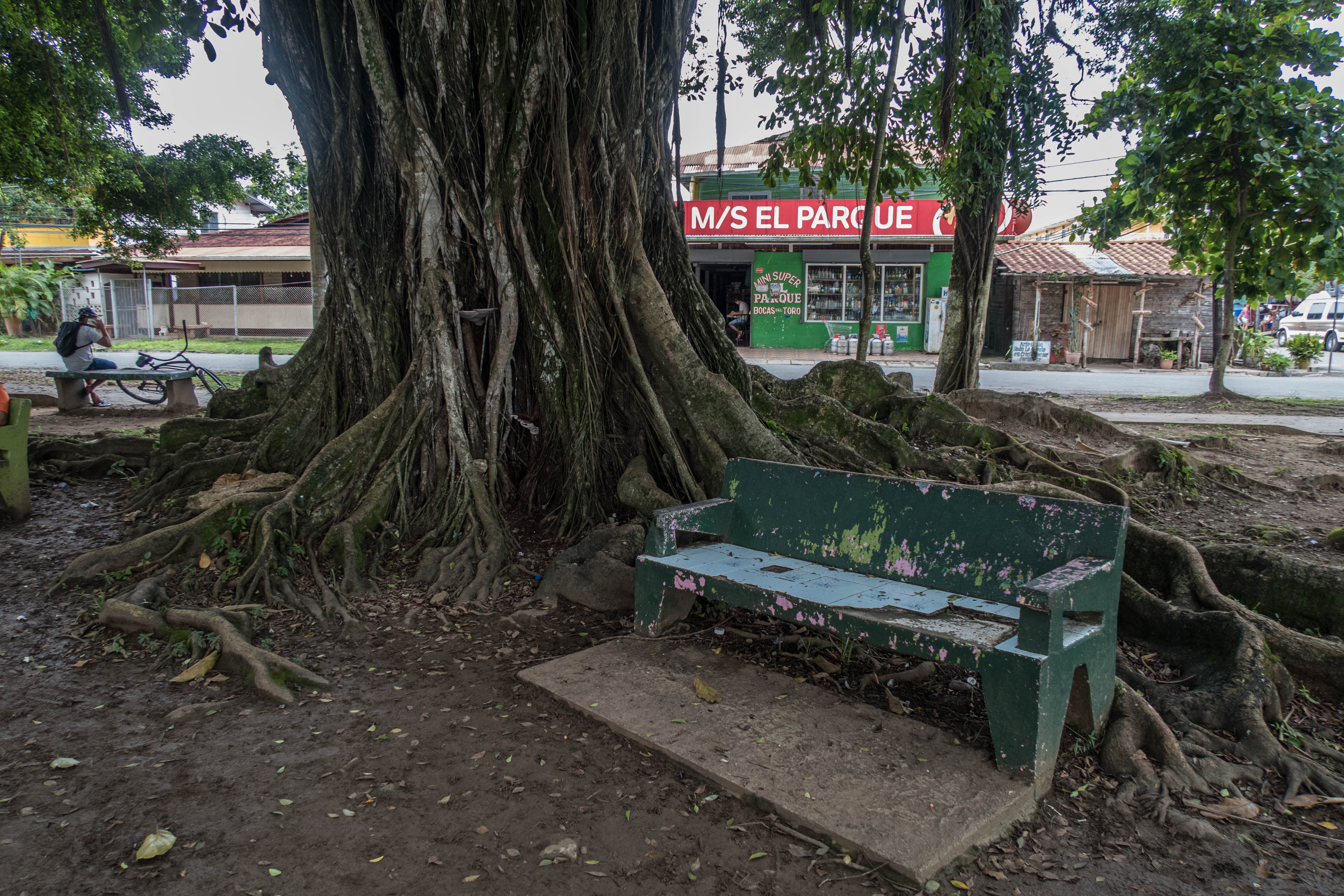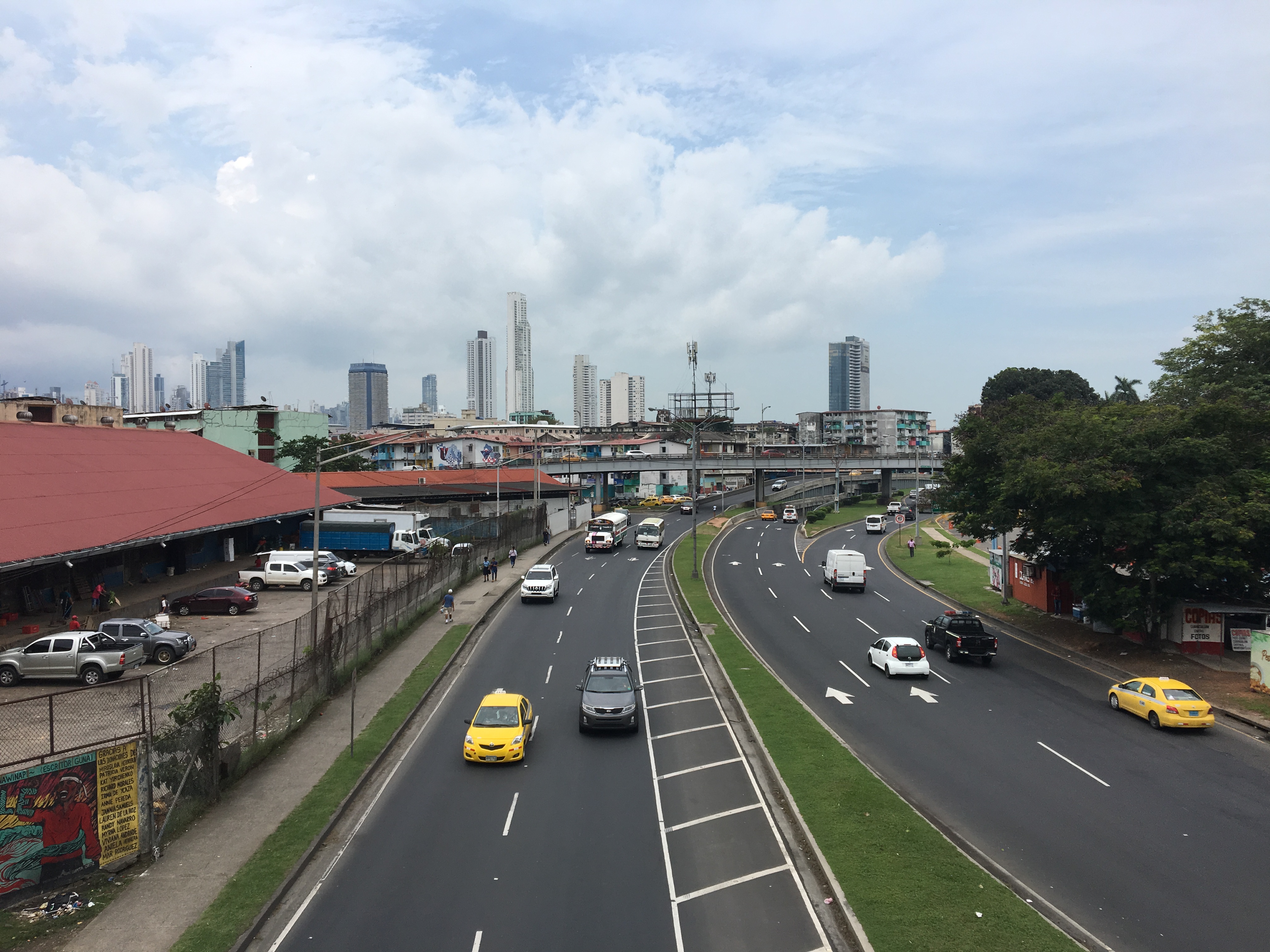This is a mandatory blog post for the Wagoner Foreign Study Fellowship.
As mentioned in my previous blog post, I spent some time in Bocas del Toro to myself, walking around the main street of the town and quietly people-watching. It was an overcast Saturday afternoon, and I sat down at the public park to eat a sandwich and watch the locals and tourists around me enjoy a day off.

Check out my last post for a picture of the park. Here’s one of the benches, next to the awesome root structure of an old tree!
While parents sat down on one of the many benches relax in the shade of tall tropical trees, small gangs of children played pretend with each other and ran around the playground nearby. People from all over the world were perusing the wares of indigenous vendors for a unique souvenir to bring back home. Haggling isn’t necessarily explicit here, but definitely possible. The streets were empty enough to walk in the middle of them, which gives a view of one side of town to the other.
Here, Latin American time is more apparent. Life moves slowly and the general attitude of people is relaxed and friendly. Everyone knows each other here, which makes the small town feel even cozier. For example, I talked to Randolf, a Bocatorreno (Bocas local), about how the trash problem, small business greed, and development has changed on the island during his lifetime. People are easy to approach here, and everyone promotes each others’ businesses with stickers and word of mouth. The presence of the ocean must contribute to this somehow – whether people spend their time surfing or driving around people in boat taxis, people float about their daily activities and do not stress about being on time or staying productive.
However, in Panama City, things are different. Although I’m only an hour-long flight away from Bocas, the hustle and bustle of a large city takes over Latin American time. Traffic is persistent and aggressive, and people are always rushing from one place to another. The Panama Canal is always a looming presence, since the city lines the water and you can see large shipping boats constantly waiting their time to pass through. Industry and commerce occupy the downtown area, along with swanky large hotels.
I spend a good amount of my time working in a lab, so I don’t get a chance to observe a daily Panamanian’s life all that often. One thing that is apparent is the huge income inequality here – the glass high-rises don’t describe a huge proportion of the population. I’m still hesitant to walk alone on busy streets in some of the neighborhoods around me, but I can tell that between one street and another, there are totally different avenues of life taking place in a densely packed area.
One of my favorite places that I have gone so far is the Mercado de Abastos, or Wholesale Food Market. Here, informal stands of produce are displayed in an open air market and you get to walk through a maze of freshly picked produce. The more you buy, the cheaper the food is, making for great group-cooking potential. Some farmers are more vocal with their products, while others try and stay cool with a soda and just stare at you. I purchased two ripe avocados carefully selected for me by the shop owner for $1 each. I also purchased a small bag of “mamonchinos,” or rambutan, for a dollar and enjoyed the sour-sweet taste of this hairy and colorful fruit back at my dorm.

Mamonchino, or rambutan, is definitely another unusual looking tropical fruit. It’s related to the lychee!
A fusion of the city and Bocas happened when I was in Casco Viejo, an incredibly touristy part of Panama City that I spend a lot of time in for its coffee shops and architecture. I happened across a man’s stand that sold some hand-made jewelry and in particular, a shark tooth necklace that caught my eye. His jewelry resembled that of someone I knew in Bocas named Pablo, who handcrafted jewelry from stones and things he collected from all over. I looked up to see someone wearing Bocas del Toro shirt and immediately started talking to him about Pablo, doing marine biology in Bocas, and more. He introduced himself as Tote and told me that he was actually best friends with Pablo (“como uno hermano”) and that his mom’s name is Elena, which is my name in Spanish! His brother is also the one responsible for all the “Sweet Love Bocas” tagging all over the main part of town.
The world became so small all of a sudden. Here in front of me was someone who was born and raised in Bocas del Toro, who knew exactly what I was talking about when I said that Bocas people were some of the friendliest people in Panama. He said the city-dwellers are always focused on profit and money, while Bocas people were more about having a good time and spreading “good energy.”
Another vendor nearby who was from the city came to disagree with him a bit, saying that profit-hungry city people was a huge generalization/stereotype. Regardless, they gave each other a friendly fist-bump and continued to participate in the tourist-jewelry hustle together. I left with a shark tooth necklace from Tote and a little crystal he gifted me for the serendipitous meeting we had.
Panama has a huge natural biodiversity and cultural diversity as well. Between urban and rural, coastal and agricultural, you can see the people become products of their environment (and vice-versa, of course). While admittedly, I am not as comfortable spending time alone in a foreign country unless I feel totally safe (which is usually in more tourist-y, English-heavy areas), the Panamanian spirit is still quite contagious and very different from that of the United States. But more on that in another post!




Very interesting observation,havefun!